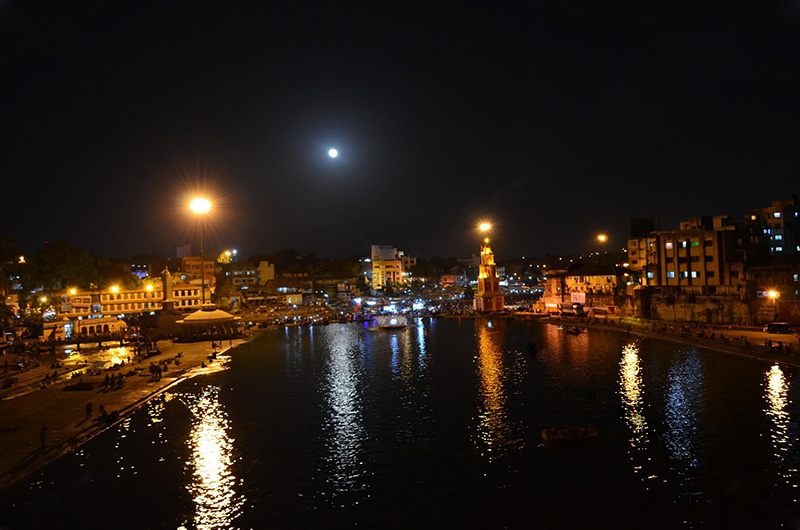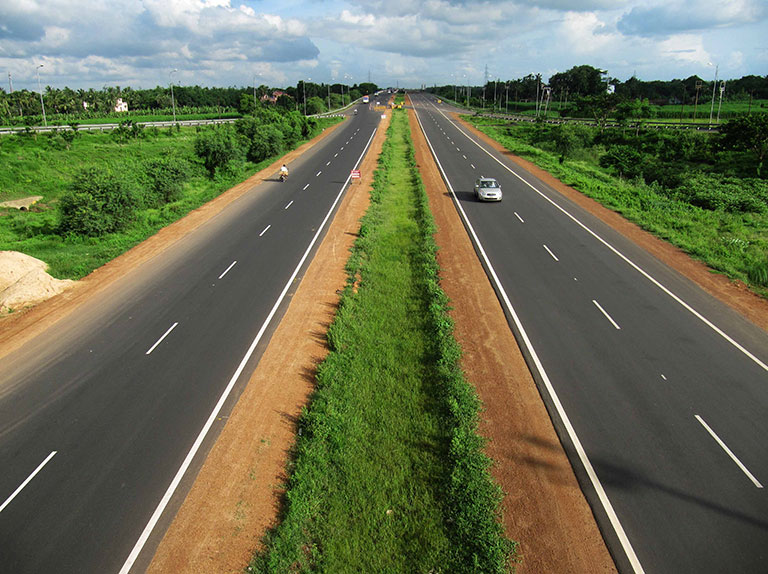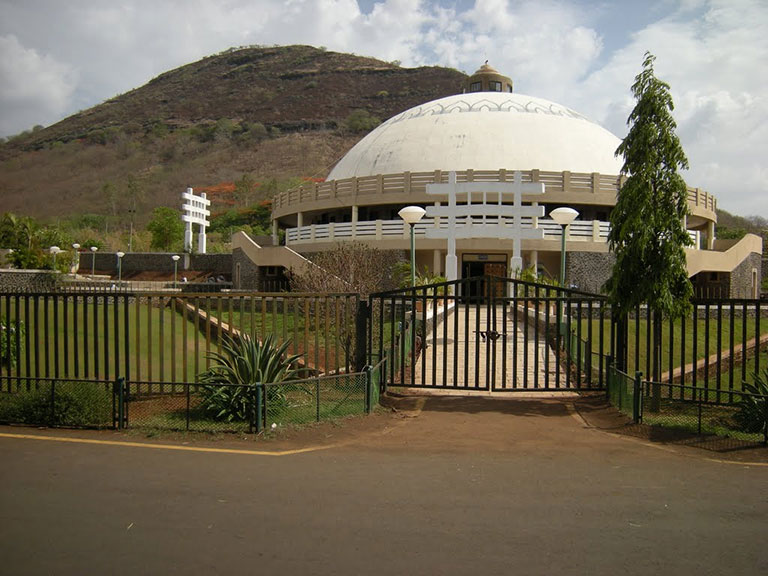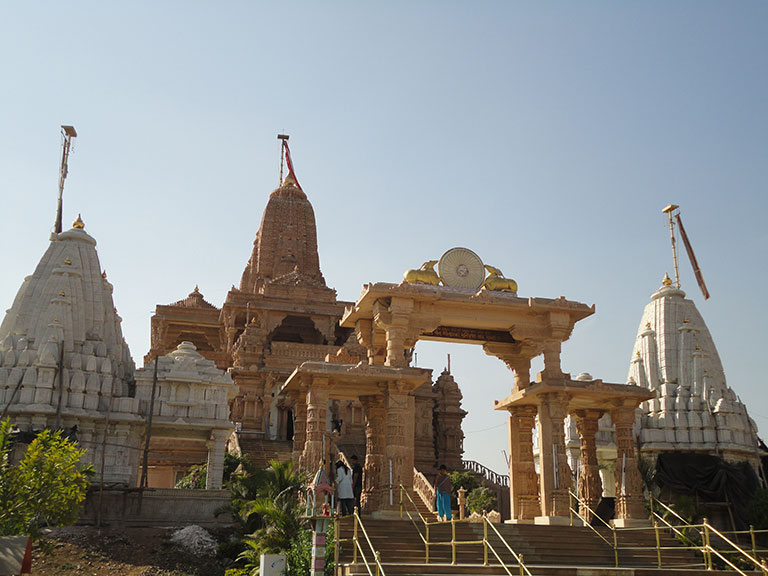|
|
|
|
Hindu mythology has it that Lord Rama, the King of Ayodhya, made Nashik his home during
his 14 years in exile. At the same place Lord Laxman, by the blessing of Lord Rama, cut
off the nose of Shurpnakha and thus this place was named as "Nasik"(From Sanskrit word
'Nasika'). Several other references to the Ramayan era can be found in Nashik, which
includes the Sita Gumpha caves, from where Sita, Lord Rama's wife, was abducted by Ravana.
Nashik in 150 BC was believed to be the country's largest marketplace.
|
|
|
From 1487-1818, the city was under Mughal rule and was known as Gulshanabad (City of
Gardens).
The city got its present name in 1818 when the Peshwas got control of the city. The Peshwa
rule however, did not last long and the British captured Nashik in the very same year. In
1840, one of the first modern libraries of Maharashtra (then, the Presidency of Bombay)
was founded at Nashik.
Some of the major events in history of Nashik in the 1860s are-
-
1840 : Sarvajanik Vachanalaya established.
(Public Library)
- 1854 : Sharanpur Colony formed.
- 1861 : Deolali Cantonment formed.
- 1862 : Nashik Road railway station was built.
- 1864 : Nashik Municipality formed.
- 1869 : Nashik district formed.
- 1894 : Saint Andrew Church built.
-
1894 : Construction work for Victoria Bridge
started.
- 1910 : Police Training School established.
- 1922 : Distillery started at Nashik Road.
- 1927 : Security Press formed at Nashik Road.
-
1941 : Artillery Center migrated to Nashik Road from Quetta in
Pakistan.
Nashik also participated in the freedom struggle of India. On December 21, 1909,
17-year-old Anand Kanhere shot the Collector of Nashik, Jackson in a theatre named
Vijayanand theatre, where he had gone to see a play Sharada. He died on the spot. The
people involved in the incident, Anant Kanhere, Krishnaji Karve and Vinayak Ramchandra
Deshpande were sentenced to death by hanging and were hanged soon after.
In 1914, social worker, Raosaheb Thorat founded the Nashik District Vidya Prasarak Samaj,
the most prominent educational institute in Nashik.
In 1930, the Nashik Satyagraha was launched under the leadership of Dr. Babasaheb Ambedkar
for the entry of Dalits in Kala Ram temple. In 1931, a meeting of the Bombay Province
Charmkar Parishad was organised at Nashik to work out the Chambhars' position with regard
to the Second Round Table Conference in which Babasaheb was going to participate. In 1932,
Babasaheb organized his temple entry movement for the abolition of untouchability in
Nashik.
Balkrishna Moonje, a close associate of Veer Sawarkar, established the Central Hindu
Military Education Society at Nashik which created the Bhonsala Military School in
1937.
During the Partition of India in 1947, many Sindhi families migrated to Nashik
On October 31, 1955, the Government of India inaugarated a press at Nashik for printing
government stationery.
|
|
|
|
|
|
|
Kumbhamella is a glorious gathering of Sadhus as well as Pilgrims at a place on some
specific days. The gathering is of 10 to 15 lakh people on a day at Nashik. As per the
legend, the Amrut was spilled in the Ramkunda and thus on a specific day, by taking bath
on the Ghats, on attain 'Moksha'. This period is called Sinhastha at Nashik and
Kumbhamella at other places. It is held after every 12 years. The other places where
Kumbhamella is held are Ujjain, Allahabad & Haridwar. The 'Holy place' status thus
attained is directly linked with the 'Holy dip' in the river at the 'Holy Ghats'. The
river Godavari which passes through the city, is having length of 18 kms, in the Municipal
Corporation area. There are few villages on the banks. Also the old part of the city is
located on both banks. As per the religious beliefs, the stretch of the river from
Ahilyabai Holkar Bridge to the Ram setu bridge is considered to be most sacred.
Temples :
- Kala Ram Temple - Year 1782 by Odhekar family
- Sunder Narayan Temple - Year 1756 by Peshwas
- Umamaheshar Temple - Year 1758
- Nilkantheshwar Temple - Year 1747
- Goreram Temple - Year 1720-1740
- Naroshankar Temple - Year 1747 by Naroshankar Rajebahadur
Kundas :
- Ramkunda - Year 1761-1772 by Peshwas
- Murudeshwar - Year 1770
|
|
|
|
|
|
|
Nashik is located in northern Maharashtra at 565m (1854 ft) from the mean sea level. The
river Godavari originates from Trimbakeshwar (24 km from Nashik) and flows through various
parts of the city. The river forms the northern boundary of the city in some areas and
then flows through the old residential settlement in the city. Several small tributaries
like the Nasardi and Waghadi merge with Godavari at Nashik. Nashik lies on western edge of
the Deccan Plateau which is a volcanic formation. The soil here is primarily black which
is favorable for agriculture. The total land area of the city (Municipal Limits) is about
259.13 km2 which makes it the third largest urban area of Maharashtra after Mumbai
Metropolitan Region and the Pune and Pimpri Chinchwad Urban Region.
Nashik has pleasant climate for most time of the year except from March to mid-June. The
period from June to September is the (South West) Monsoon Season. October is peculiarly
hot and dry. Winter is between November and February. In 1914, social worker, Raosaheb
Thorat founded the Nashik District Vidya Prasarak Samaj, the most prominent educational
institute in Nashik.
The maximum temperature ever recorded in the city was 44.8 °C (108.3 °F) on 12 May 1960
in Nashik. The lowest temperature recorded was 0.6 °C (33.1 °F) on 7 January 1945 in
Nashik. In 1930, the Nashik Satyagraha was launched under the leadership of Dr. Babasaheb
Ambedkar for the entry of Dalits in Kala Ram temple. In 1931, a meeting of the Bombay
Province Charmkar Parishad was organised at Nashik to work out the Chambhars' position
with regard to the Second Round Table Conference in which Babasaheb was going to
participate. In 1932, Babasaheb organized his temple entry movement for the abolition of
untouchability in Nashik.
|
|
|
|
|
|
|
The older quarters of the city are peculiar to many similar cities of Maharashtra such as
Pune, Satara and Kolhapur. It is characterized by the wadas (a housing typology, wada
would mean a courtyard house), narrow, shaded, winding streets, peculiar projections onto
the street, streets swelling into a chowk (public courtyard) and the vibrant and active
bazaar (market) streets leading towards the river (in many cases). Streets are identified
by the goods they sell and still attract large number of buyers from the city and more so
from adjoining towns and villages.
The planned areas of CIDCO :
About 396 Ha of land
area of the city has been planned and developed by City and Industrial Development
Corporation (CIDCO). This area (originally a part of Morwadi and Untwadi villages) abuts
the two industrial areas of the city viz. Satpur and Ambad and is home to a large number
of residents who work in the industries. Since the area is planned as a single exercise it
has a peculiar visual character and a unique community mix.
New development: Sprawling single residences and apartments :
Areas like College Road, Mahatmanagar, Savarkar Nagar, Kathe Galli, Jail Road, Jaibhavani
Road, Indira Nagar, Pipeline Road could loosely be categorized as the newly developed
outer areas of Nashik. Quite a few prominent educational institutions are located in these
areas and so are the modern day restaurants, coffee shops and hangouts of the young. Most
of the construction in this zone has happened in the past 3 to 4 decades and comprises
individual houses and multistory apartments. Almost all retail malls and multiplexes in
the city are located in this zone.
Architecture :
Rock-cut architecture
Rock-cut caves called Pandavleni Caves relating to Hinayana Buddhism are located near
Ambad, about 10 km from the city center. The caves are believed to be carved out between
1st century BC and 3rd century AD. There are 22 caves which comprise of chaitya and vihara
with varying levels of carving and detail.
Temples of Nashik
The city is home to hundreds of temples and shrines notably at the Ghats near Ramkund
(which is the stretch of the river considered holy as it changes its course from westward
to southward). The Kalaram Temple, The Naroshankar Temple and the Sundernarayan Temple are
most significant architecturally, all built in black basalt stone. Trimbakeshwar temple is
30 kms from Nashik.
Traditional Wada typology of old Nashik :
The old city's hosing
quarters primarily comprise of the wada typology. These are built-to-edge courtyard houses
with rooms built a central (multi-activity) courtyard opening onto a street. This typology
is a fine example of climate control and resulted into the peculiar urban form of narrow
shaded streets and public courtyards.
Contemporary Residential Architecture :
The urban form of outer
Nashik used to be dominated by (generally) well-designed two story independent houses. As
land costs soared these have been replaced by either row houses (houses with common side
walls) or multistory apartments. The last decade has witnessed a trend of clusters of
multiple buildings with a mix of typologies served by common amenities like a club and a
swimming pool.
Contemporary Institutional and Public Architecture :
There are a
few architecturally notable public buildings in Nashik like The Nashik Municipal
Corporation Administrative Headquarter, The Kusumagraj Smarak and The Dadasaheb Phalke
Memorial at the foothills of Pandavleni Caves. Some of the recent projects comprising
educational campuses and corporate buildings have demonstrated reasonable architectural
flair at par with national and international architectural trends.
Parks and Public Spaces :
- Dadasaheb Phalke Memorial
- Shivaji Garden
- Shagun Water park (Largest water park in Nasik)
- Jawaharlal Nehru Udyan
- Various Neighborhood Parks developed and run by the Nashik Municipal Corporation
- Goda Park
- Various Jogging Parks developed and run by the Nashik Municipal Corporation
- Dongre Vastigruha Ground
- Zilla Parishad Stadium Complex
- CIDCO Stadium
- Phalke Smarak
- Pramod Mahajan Udyan, Gangapur Naka
Auditoriums and Drama Theatres :
- Mahakavi Kalidas Natyamandir
- Parshuram Saikhedkar Natyagriha
- Dadasheb Gaikwad Sabhagriha
- Paluskar Sabhagriha
- Rasbihari International School
Cinema Theaters and Multiplexes :
- Ashok Theater
- ChitraMandir
- Vijayanand
- Damodar
- Anuradha, Nashik Road
- Prabhat Cinema
- Vikas
- Circle
- Mahalaxmi
- Cinemax, College Road
- Cinemax Regimental, Nashik Road
- BIG Cinemas (Adlabs)
- Fame Nashik
- Cinemax, City Centre Mall
Retail Shopping Malls in Nashik
- The Nasik City Centre (Largest in Asia ).
- The Zone (Big Bazaar), College Road
- Big Bazaar, Nashik Road
- SK Mall (College Road)
- Pinnacle Mall (Golf Club)
- Vishal Mega Mart (Bombay Naka)
- Nashik Central at Trimbak Naka
- R L Mall(Rajmal Lakhichand) (under construction) with 4 star hotel
- East End [ Mumbai-Agra Highway]
- Mall by Western India Properties at Satpur (on hold)
- Mall by Raheja in Amabad MIDC (on hold)
-
Suyojit Mall one each in Shikhare wadi (6 lakh sq.ft)& Mumbai Naka (10 lakh sq.ft)
- Kakade Magnum Mall (proposed)
- Prozone Mall (proposed)
in addition to that there is a very good presence of chain stores like Reliance fresh,
Spencer's, Spinach, Subiksha, More for you.
Cuisine :
Nashik traditionally boasts of a Maharashtrian cuisine with influences from Khandesh,
Rajasthan and Gujrat. The modern city however offers a range of restaurants with cuisines
ranging from Punjabi, South Indian to Chinese and continental cuisines.
Sports :
Cricket is the most popular sport in Nashik. The old city also patronizes traditional
Maharashtrian sports like Kabbaddi and Kho Kho. The Nashik Gymkhana is the principal place
for playing formal sports and also to get formal training. At least three swimming pools
are run by the Civil administration which are extensively utilized by the people.
Healthcare :
-
Regional Super Speciality Hospital (100 beds) run by the Government of Maharashtra
- Wockhardt Hospitals
- NDMVP's Medical College's Hospital, Adgaon
- Life Line Hospitals
- Apollo Hospital
- Sanjivan Hospital :- Orthopedic and Pediatric Hospital
|
|
|
|
|
|
|
Nashik today is one of the fastest growing cities of India and has even been identified as
a tier-2 metro. The city's economy is driven chiefly by the engineering and manufacturing
industry (which has been around since the seventies) as well as the progressive
agriculture in area surrounding the city. Auto majors such as Mahindra & Mahindra,
BOSCH and Original Equipment Manufacturers (OEMs) such as VIP, Samsonite, CEAT etc. have
their plants here and have spawned a huge network of auto component suppliers and
engineering ancillary services. It is also a pharmaceutical hub with presence
GlaxoSmithKline and Fem. In recent years, Nasik has also carved a niche for itself as
India's "Napa Valley" and locally established wine brands such as "Sula" have attained
international acclaim. Modern efforts are on to promote the growth of an export-oriented
rose farming and wine industry in the district. Nashik is also deemed "the third most
industrialised city of Maharashtra after Mumbai and Pune", mainly due to extensive
industrial development in recent times. It is home to an important thermal power plant
(Eklahare) and a National Treasury Printing Press (India Security Press at Nashik Road).
There are five "Industrial Zones" in the Nashik area and its outskirts (Satpur, Ambad,
Sinnar, Igatpuri and Dindori). Nashik has a number of sugar mills. It is also chief
exporter of white onions and pomegranates.
|
|
|
|
|
|
|
Nashik today is one of the fastest growing cities of India and has even been identified as
a tier-2 metro. The city's economy is driven chiefly by the engineering and manufacturing
industry (which has been around since the seventies) as well as the progressive
agriculture in area surrounding the city. Auto majors such as Mahindra & Mahindra,
BOSCH and Original Equipment Manufacturers (OEMs) such as VIP, Samsonite, CEAT etc. have
their plants here and have spawned a huge network of auto component suppliers and
engineering ancillary services. It is also a pharmaceutical hub with presence
GlaxoSmithKline and Fem. In recent years, Nasik has also carved a niche for itself as
India's "Napa Valley" and locally established wine brands such as "Sula" have attained
international acclaim. Modern efforts are on to promote the growth of an export-oriented
rose farming and wine industry in the district. Nashik is also deemed "the third most
industrialised city of Maharashtra after Mumbai and Pune", mainly due to extensive
industrial development in recent times. It is home to an important thermal power plant
(Eklahare) and a National Treasury Printing Press (India Security Press at Nashik Road).
There are five "Industrial Zones" in the Nashik area and its outskirts (Satpur, Ambad,
Sinnar, Igatpuri and Dindori). Nashik has a number of sugar mills. It is also chief
exporter of white onions and pomegranates.
|
|
|
|
|
|
|
In recent days, the government has decided to prepare IT parks in the city of Nashik Road.
The V-Tech park is one of the largest IT parks of Maharashtra. Nashik is also emerging as
a BPO/IT destination and is in list of the selected Tier II cities for BPO/IT companies. ;
companies like Datamatics, WNS and gloStream have presence in Nashik.
|
|
|
|
|
|
|
Nashik is very famous for grapes, onions and tomatoes, all of which are grown in huge
quantities. The wine culture is growing at an alarming speed for both growers and wine
makers.
Nashik was famous for its table grapes for a very long time. In early 1925, the Table
Grape revolution was started by Shree Ramrao Jairamji Gaikwad, who is known to have been
the first person to commercially grow table grapes, in Ojhar, a small town near Nashik. He
is known as the Father of Indian grapes and revolutionised not only grape growing, but
also other crop cultivation practices. Today, table grapes are being exported in great
quantities to Europe, the Middle East and Asia. They are used to make raisins and juices.
Nashik also exports a reasonable quantity of onions. Agriculture contributes greatly
towards the Nashik's economy.
|
|
|
|
|
|
|
Nashik has transformed from a small pilgrimage town to a modern mid-sized city in the last
two decades or so. The growth of industries brought about a major growth in population
resulting into expansion of the footprint of the city into the hinterland and resulted
into growth of suburbs along the periphery of the city. The natural benefits of geography
and climate and abundant availability of water catalyzed this growth. The retail
revolution in India also left an impact on Nashik with multiple medium and large sized
retail malls opening up in the city after the year 2002. Stand-alone branded apparel
stores and food chains followed the trend and have opened up outlets to cater to the
growing urban population. Some of the other statistics are given below:
- The literacy rate in Nashik is 85.67%.
- People living below poverty line: 5.6%
- Literacy rate: 85.67%
- Human Development Index(from 2001-2008):90.00%
- Infrastructure Development: 80%
|
|
|
|
|
|
|
Nashik has been a major transport node given its road and rail connectivity and geographic
location
|
|
|
|
|
|
|
Nashik is one of the major road junctions of India. The Mumbai-Agra national highway(NH3)
runs through Nashik. Nashik is also connected to Pune with NH-50. Nashik is a major road
junction of major state highways. It is well connected to Surat, Aurangabad, Mumbai, Pune,
Ahmednagar, Dhule and many other cities. It has been seeing reasonable grown in terms of
road infrastructure in the past few years or so. Map of Nashik Taluka The National Highway
Number 3 (NH3) is being converted into a multi-lane tolled road.
The stretch from Mumbai to Bhiwandi is already a four-lane road. Work is in progress for
the four-laning of the stretch between Bhiwandi and Gonde. This stretch passes through the
Kasara Ghat Section (known as Thalghat traditionally). It is understood that the stretch
between Gonde and Pimpalgaon Baswant (near Ozar Airport), which actually passes though
Nashik city, is proposed to be a six-laned highway with multiple flyovers at key
intersections. The work of the road beyond the one described above (Pimpalgaon Baswant to
Dhule) is nearing completion. The NH50 to Pune is a traditional two-laned road up to
Rajgurunagar (Pune District) and four laned further till Pune.
|
|
|
|
|
|
|
Buses:
MSRTC (State Run) Efficient and punctual buses are run by the Maharashtra State Road
Transport Corporation to various cities, towns and villages around Nashik. They operate
services from multiple bus terminals (New and old Central Bus Stand or CBS, Mela Sthanak,
Mahamarg Bus Stand and Nimani Bus Stand) primarily based on geographic locations of the
destinations. The new CBS (also known as Thakkar Bazaar) is the principal bus terminal
from where one can get to travel to Mumbai, Pune, Kolhapur, Satara, the Konkan Region,
Aurangabad and so on. Semi-luxury buses are available to some of the important locations.
Nashik to Pune is a special semi-luxury service which runs decently built buses at
half-hour intervals from 5.30 in the morning to 12.30 in the midnight. The Mahamarg bus
stand caters to services departing for Ahmednagar, Solapur, Kasara and Shirdi. Other bus
stands cater to district level traffic to small towns and villages.
Private Buses :
Several private bus operators run services with good quality buses (Air-conditioned buses
in many cases) although to large cities around like Mumbai, Pune, Nagpur, Ahmedabad,
Surat, Vadodara, Indore, Kolhapur etc.
Air conditioned Taxis :
Popularly knows as cool cabs (blue and silver colored), these services are available to
Mumbai, Thane, Shirdi, Pune and a few other locations. These serve as a good option in
case of unplanned travel decisions and available round-the-clock at stipulated taxi-stands
located conveniently in the city. Taxis could be hired fully or on seat-basis. One could
walk up to the taxi stand or call for the taxi at desired location although at an
additional cost.
Railways :
Nashik Road Railway Station is an important railway station on the
Mumbai-Kalyan-Manmad-Bhusaval (and further to Delhi or Kolkata) sector of the Central
Railway] Division of Indian Railways which was the first ever electrified section in
India. The railway station is about 11 km away from the city center (and hence called
Nashik Road instead of Nashik). Most of the trains halt at Nashik Road station although
generally for a short duration(2 to 5 minutes). Deolali is another station (about 10
minutes train travel towards Mumbai) which serves the population residing in the Deolali
Cantonment Area and the adjoining towns like Bhagur etc. Interestingly, a horse-drawn tram
used to ply between Nashik Road Station and the Nashik City between 1889 and 1933.[21]
More than 50 trains pass through this station daily and it is thus connected to Mumbai,
Aurangabad, Nanded, Hyderabad, Bhopal, Agra, Delhi, Nagpur, Kolkata, Guwahati, Jammu,
Madgaon, Mangalore and so on. Although the station connects to most northern and eastern
parts of the country, major passenger traffic is between Mumbai and Nashik. Fast-moving
intercity trains like the Panchvati express and the Godavari Express connect this station
to Mumbai. These trains originate from Manmad and principally cater the large number of
business travelers from Manmad and Nashik to Mumbai and suburban area.
Airways :
Kingfisher Airlines runs two daily flights to Mumbai from
Nashik's Ozar Airport located at some 24 km from the city center. Deccan Airways also used
to operate a flight to Mumbai from Ozar airport a couple of years ago which was later
taken off due to lack of passengers. Nashik has another airport at Gandhinagar with a
shorter runway and hence unfit for modern-day passenger aircrafts. The government run
Vayudoot used a operate a service to Mumbai from this Gandhinagar Airport during the
1980s.
Intracity Travel :
Nashik has been having a reasonably reliable and punctual bus based intra-city transport
system which is operated by the state run MSRTC. The principal operating hub is at
Panchvati. Other key city bus nodes are Nashik Road (Railway Station), Satpur, Central Bus
Stand and Shalimar. Buses ply to almost all parts of the city. The MSRTC has been
requesting the [Nashik Municipal Corporation] http://www.nashikcorporation.com/ to take
over the bus service but that has not happened till date. Peculiarly painted Taxis (Black
and Yellow) are available for point to point (unmetered) travel to destination within the
city and to nearby tourist attraction like Trimbakeshwar and Someshwar or the Railway
Station. Metered and unmetered auro-rikshaws ply in the city and are available with
reasonable ease.
|
|
| |




